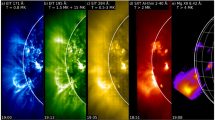Abstract
New radial velocity measurements of the Algol-type eclipsing binary AI Dra, based on Reticon observations, are presented. The velocity measures themselves are based on fitting theoretical profiles, generated by a physical model of the binary, to the observed cross-correlation function (ccf). Such profiles match this function very well, much better in fact that Gaussian profiles which are generally used. Measuring the ccf's with Gaussian profiles yields following results: mp sin3 i=2.55± 0.05m⊙, ms sin3 i = 1.14 ± 0.03m⊙, (ap + as) sin i=7.34 ±0.05R⊙, and mp/ms =2.23± 0.05. Where as measuring the ccf's with theoretical profiles yields a mass ratio of 2.33 and following results:
mp sin3 i=2.84± 0.05m⊙, ms sin3 i=1.22 ± 0.03m⊙, (ap +as) sin i=7.56± 0.05R⊙.
The system comprising a semi-detached configuration. From the solution of a previously published light curved and combining it's results with the spectroscopic orbit, one can lead to the following physical parameters: mp =2.99m⊙, ms =1.28m⊙, > Tp < =9600 K, > Ts < =5400 K, > Rp < =2.35R⊙, > Rs < =2.12R⊙. The system comprising an AO primary and a secondary of G2 spectral type.
Similar content being viewed by others
Author information
Authors and Affiliations
Rights and permissions
About this article
Cite this article
Khalesseh, B. Spectroscopic Orbit of the Eclipsing Binary AI Draconis. Astrophysics and Space Science 260, 299–307 (1998). https://doi.org/10.1023/A:1001705122297
Issue Date:
DOI: https://doi.org/10.1023/A:1001705122297




